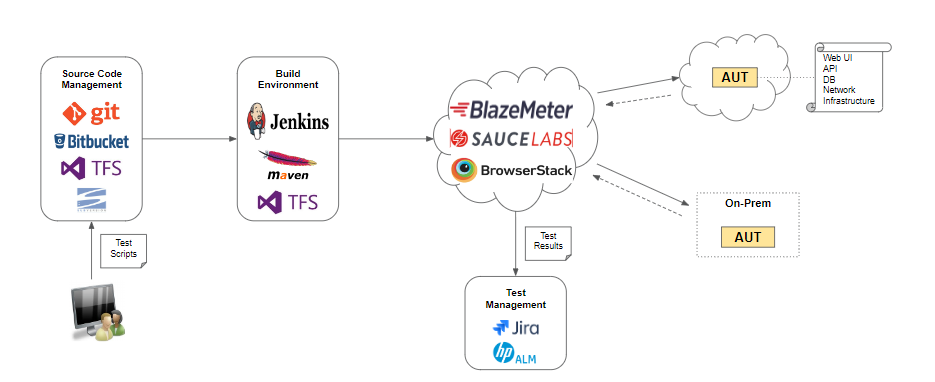Introduction
Cloud-based testing, an integral component of contemporary software development, is at the forefront of the IT industry’s significant transformation. This transformation is primarily driven by the adoption of ‘Virtualization,’ a revolutionary concept that utilizes cloud computing to offer solutions ‘as a Service.’ This allows for accessing shared resources across various operating systems, browsers, and platforms. This article aims to provide a comprehensive overview of cloud-based testing, covering its definition, types, benefits, and the challenges it presents.
What Is Cloud-Based Testing?
Cloud testing, often called ‘Cloud-Based Testing,’ occurs in a third-party cloud computing environment to support application testing. This approach assesses the quality of software and hardware applications in terms of performance, reliability, and security within a tester’s cloud environment. While the testing process remains similar to conventional methods, cloud testing offers advantages such as faster delivery, cost-effectiveness through the ‘pay-per-use’ model, and testing flexibility.
Cloud Computing
Cloud computing encompasses three key categories:
Software as a Service (SaaS)
In this model, the testing environment (including test tools) is hosted in the cloud, while the application can be either in the cloud or on-premises. Users can access this centralized cloud environment via a web browser, reducing operational costs. Examples of SaaS providers include BrowserStack, Sauce Labs, Salesforce, Google Workspace, and CISCO.

Platform as a Service (PaaS)
PaaS offers a development and deployment framework where third-party providers provide software and hardware resources. This model is cost-effective and grants testers access to necessary resources. Examples include Windows Azure, Force.com, and OpenShift.
Infrastructure as a Service (IaaS)
IaaS provides on-demand computing, storage, and networking resources, allowing organizations to procure resources as needed instead of investing in hardware. IaaS cloud vendors host infrastructure components, and testers set up test environments on this infrastructure. This model is relatively more expensive than SaaS or PaaS and includes providers like AWS, Digital Ocean, and VCloud Express.

Types of Testing in Cloud-Based Applications
Before embarking on cloud-based testing, it’s essential to understand the various types of testing and select the right tools and services based on project requirements and organizational preferences. Cloud testing accommodates both functional and non-functional testing, encompassing a range of critical testing types:
System Testing
- Objective: System testing ensures all application functionalities work as expected without issues.
- Importance: This is the foundation of testing where the application’s core functions are rigorously examined. It validates that every feature performs its intended tasks without errors.
Interoperability Testing
- Objective: Interoperability testing validates the application’s compatibility with other software it interacts with, which is crucial for systems communicating with multiple systems.
- Importance: In a connected world, applications must communicate with other software components. Interoperability testing ensures seamless integration and data exchange between systems.
Performance Testing
- Objective: Performance testing identifies performance bottlenecks under heavy loads and concurrent users through stress and load testing.
- Importance: Performance is a critical factor in user satisfaction. Stress and load testing simulate real-world scenarios to ensure the application can handle peak loads without slowdowns or crashes.
Availability Testing
- Objective: Availability testing ensures the application functions seamlessly despite cloud provider glitches or component failures.
- Importance: In a cloud-based environment, components can fail or experience disruptions. Availability testing guarantees that the application remains operational, minimizing downtime and ensuring a reliable user experience.
Disaster Recovery Testing
- Objective: Disaster recovery testing evaluates application data security and recovery mechanisms in case of cloud outages or unforeseen issues.
- Importance: Cloud outages or unexpected disruptions can lead to data loss and downtime. Disaster recovery testing ensures data integrity and the ability to recover swiftly, safeguarding business continuity.
Security Testing
- Objective: Security testing identifies application code vulnerabilities to protect customer information.
- Importance: Security is paramount, especially when dealing with sensitive customer data. Security testing uncovers potential weaknesses, helping prevent data breaches and maintaining trust.
Browser Performance Testing
- Objective: Browser performance testing ensures optimal user experiences across various devices, browsers, and operating systems.
- Importance: Users access applications on diverse platforms and browsers. Browser performance testing guarantees a consistent and responsive user experience, regardless of the combination of devices and browsers used.
Each of these testing types plays a crucial role in assuring the quality and reliability of cloud-based applications. By conducting a comprehensive suite of tests, organizations can minimize risks, enhance user satisfaction, and deliver robust software solutions in the dynamic world of cloud computing.
Benefits and Challenges of Cloud Testing
Let’s delve into the significant benefits and key challenges of cloud testing:
Benefits
Cost-Effectiveness:
Cloud testing operates on a pay-per-use model, allowing organizations to optimize their testing budgets. This approach eliminates the need for substantial upfront investments in testing infrastructure and tools, making it a cost-effective choice. It ensures that resources are allocated efficiently and organizations pay only for the specific testing services they utilize, reducing unnecessary expenses.
Availability and Collaboration:
Cloud resources are accessible from anywhere with a network connection, enabling real-time collaboration among testing teams. Cloud testing facilitates efficient communication and cooperation, whether team members are in different geographic regions or working remotely. This advantage is vital in modern software development, where teams often span multiple locations and time zones, ensuring that testing efforts proceed seamlessly.
Scalability:
One of the significant advantages of cloud testing is its scalability. Organizations can easily adjust the scale of testing resources to match their evolving requirements. This flexibility accommodates varying testing workloads, whether small-scale projects or large-scale testing efforts during peak periods. Scalability ensures testing environments adapt swiftly to changing demands, improving overall efficiency.
Customization:
Cloud environments offer the ability to customize testing scenarios to replicate real-world conditions accurately. Testers can tailor these environments to closely mimic the production environment, leading to more accurate and reliable testing results. However, it is crucial to thoroughly understand the environment’s specifications to ensure that customizations align with the intended testing objectives and refrain from introducing integration issues.
Simplified Disaster Recovery:
Cloud-based data backup and recovery processes are streamlined compared to traditional models. Cloud providers typically offer robust disaster recovery mechanisms, ensuring data integrity and minimal downtime. In unexpected disruptions, data loss, or system failures, organizations can rely on these built-in recovery capabilities to maintain business continuity and safeguard critical data.
Challenges
Security:
The shared nature of cloud environments and multi-tenancy can introduce security challenges. Withred infrastructure may become vulnerable to threats and be protected by security measures. Security concerns can also impact performance, as stringent security protocols may lead to latency or additional processing overhead. Ensuring robust security measures is paramount when dealing with cloud-based testing, especially when handling sensitive data.
Configuration Compatibility:
Some cloud providers may not support specific configuration combinations required for testing. This lack of compatibility can result in complications during the testing process, potentially leading to inaccurate results and delays in project timelines. Organizations must carefully assess the compatibility of their chosen cloud environment with their testing requirements, taking proactive steps to address any potential issues and ensure smooth testing workflows.
Data Privacy and Compliance:
Managing data privacy and complying with regulatory requirements can be challenging in a cloud testing environment, especially when sensitive data is involved. Organizations must navigate data protection regulations and ensure data handling and storage practices adhere to legal and industry standards.
Resource Management:
Efficient resource management is essential to control costs and optimize performance in a cloud testing environment. Organizations must monitor and manage resources effectively, avoiding over-provisioning or underutilizing resources, which can impact both budget and testing outcomes.
Vendor Lock-In:
Depending on a specific cloud provider’s services and tools can lead to vendor lock-in, making it challenging to migrate to a different provider or cloud model in the future. Organizations should consider strategies to mitigate vendor lock-in risks, such as adopting cloud-agnostic tools and architectures.
Latency and Network Issues:
Testing applications in the cloud may introduce latency and network issues that can affect the accuracy of performance testing results. Organizations must account for network latency and simulate real-world conditions to ensure performance testing accurately reflects user experiences.
Testing Tool Compatibility:
Ensuring compatibility between testing tools and the chosen cloud environment can be challenging. Organizations must verify that their selected testing tools seamlessly integrate with the cloud platform, avoiding tool-related bottlenecks or limitations.
In conclusion, testing cloud-based applications is an indispensable aspect of modern software development. While it offers a plethora of benefits, including cost-effectiveness, scalability, and collaboration, organizations must navigate a range of challenges, from ensuring data privacy and compliance to addressing resource management and vendor lock-in concerns. By understanding these nuances and adopting proactive strategies, organizations can harness the full potential of cloud testing, delivering robust and reliable software solutions in an ever-evolving technological landscape. Embracing cloud-based testing practices enables organizations to stay competitive, enhance user satisfaction, and ensure the success of their applications in the dynamic world of cloud computing.
For questions or inquiries about our Testing Center of Excellence, please contact us.

